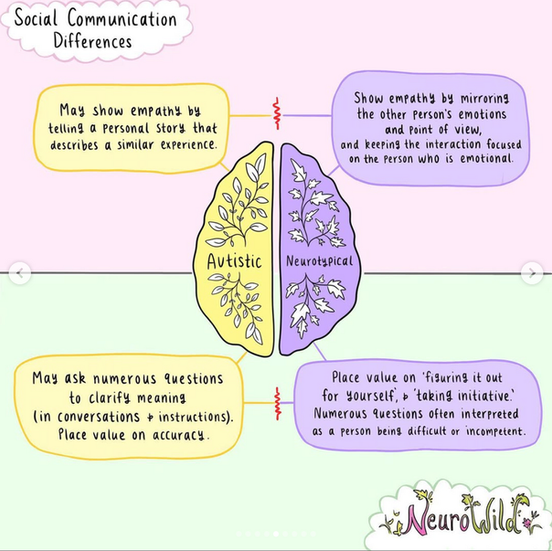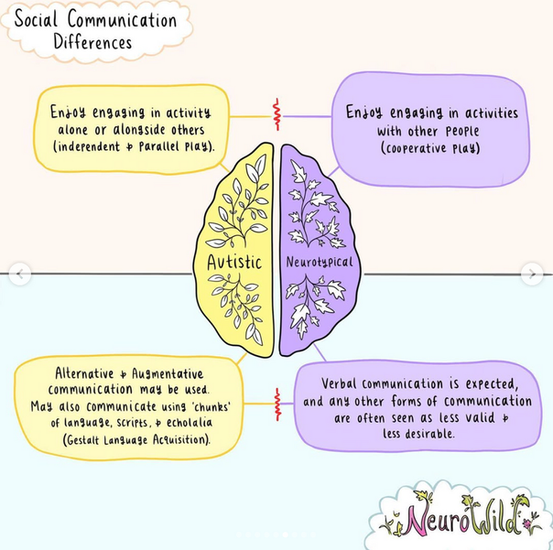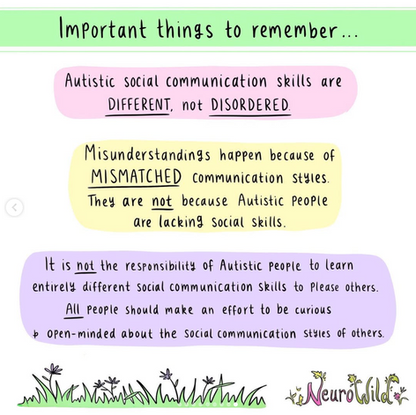Empathy is a Two-Way Street: Viewing Neurodivergent Social Skills through a Neuro-inclusive Lens
- Dr. Erica L. Norman
- May 3, 2025
- 5 min read
Updated: Jun 30, 2025
It's Autism Acceptance Month, and lately I've been having some great (and often difficult) conversations about how society can better accept and accommodate Autistic people. One common theme that keeps coming up is the topic of social skills. If you're familiar with neuro-affirming practices, you probably know that we don't teach or "train" traditional social skills. I wrote this blog to explain the why behind the neuro-affirming approach to social supports and share ideas about how we can honor all communication styles in an inclusive, accepting way.
When you think about "social skills," what comes to mind? Many people think about societal and cultural expectations for eye contact, body language, tone of voice, turn-taking, and so on.
If you're neuronormative, (meaning that you don't identify as neurodivergent), then you might not have put much thought into your own social skills. For many neurotypical people, it's easy to pick up these unwritten "rules" and conform to the neurotypical expectations. But for neurodivergent people (those whose brains differ from the norm, like Autistics or ADHDers), these social skills often don't come as naturally. In fact, complying to some of the neurotypical expectations can be distressing, painful, or traumatic.
This is where the concept of Double Empathy comes into play—an idea that challenges traditional views on social skills and offers a fresh perspective on what a truly inclusive society might look like. So, what is Double Empathy anyway?
Unpacking Double Empathy The term "Double Empathy Problem" was introduced by Dr. Damian Milton in 2012, highlighting a mutual lack of understanding between neurodivergent and neurotypical people. It is based on the idea that neurodivergent social skills are not "wrong" or "bad," but just a different set of expectations than traditional, neuronormative social skills. The core of this problem lies not in a deficiency within any one group, but in a mismatch of communication styles and perspectives.
Rather than placing the responsibility solely on neurodivergent individuals to adapt to societal norms, Milton suggested that both groups can benefit from learning about other communication styles.
Imagine two radio stations broadcasting on different frequencies. Each station transmits clear messages, yet neither can tune into the other's signal without interference. This metaphor illustrates how both parties experience difficulty in fully comprehending each other’s social cues and emotional expressions. The Double Empathy Problem suggests that empathy gaps are bidirectional, requiring effort from all involved to bridge these divides.

Another great metaphor explaining this phenomenon is this comic (right) created by Tzipporah Johnston.
Click the arrows on the right and left of the image to swipe between the pages to learn more about Johnston's view of Double Empathy Theory. P.S. -- the last page is our favorite!
Reframing Expectations:
Beyond Traditional Social Skills
Traditionally, social skills have been measured against the standard of what is considered "normal" by society, often determined by those in positions of power and privilege. However, what if we reimagined these skills from a broader, more inclusive perspective?
A truly inclusive society requires rejecting neuronormativity and accepting differences as the norm. There is a fundamental understanding that there is no one "correct" way to exist in this world -- there is no "right" or "wrong" way to think, feel, communicate, play, behave, pay attention, learn, etc. Neurodivergent people often possess unique ways of engaging with others—ways that might be overlooked or undervalued under conventional, neuronormative frameworks.
For instance, an Autistic individual may express empathy differently, such as through actions rather than words or by offering practical solutions instead of verbal comfort. An ADHDer might show their excitement and engagement by jumping into a conversation mid-sentence. Recognizing these diverse expressions requires expanding our definition of social skills beyond rigid norms. When we think of Neurodivergent or Autistic social skills as different, not disordered, it leads to a mutual understanding that allows us to have more authentic, satisfying interactions.
One of our favorite AuDHD creators, Em Hammond of @neurowild_ on Instagram, made a series of graphics explaining common communication differences between Autistic and neurotypical people. While this is specific to Autism, and doesn't encompass all neurodivergent experiences, it's a great example of how Autistic social skills don't need to be "fixed" or "cured." What if we just accepted them as a different, equally valid set of social skills? Swipe through the images below to learn more about these differences. Maybe you recognize a few in yourself or your friends & loved ones!
Embracing Neurodiversity: A Call for Inclusivity
To foster genuine inclusivity, it is essential to embrace neurodiversity-affirming practices that recognize and celebrate differences. Here are some steps we can all take toward a neuro-inclusive future:
1. Cultivate open-mindedness: Approach interactions with curiosity and openness rather than preconceived notions about how communication should occur.
2. Listen to understand: Engage deeply with others' perspectives by listening attentively without making assumptions or jumping to conclusions.
3. Encourage self-expression: Create spaces where individuals feel safe expressing themselves authentically without fear of judgment or pressure to conform.
4. Value diverse contributions: Recognize that everyone brings valuable insights and strengths to the table; diversity enriches our collective understanding.
By adopting these practices, we pave the way for meaningful connections across neurological differences—a harmonious symphony where every note matters.
Building Bridges: Practical Strategies for Connection
Bridging empathy gaps requires intentional effort from both sides—the willingness to meet halfway while acknowledging each other's experiences as valid and important.
For Neurotypical Individuals:
Educate yourself & listen to neurodivergent perspectives: Learn about various neurodivergent identities from individuals within those communities. Once you've educated yourself, share this information with other neurotypical people!
Practice patience: Understand that processing information might differ among individuals; give ample time for responses without rushing conversations.
Do not make assumptions: When unsure about someone’s needs or preferences during interactions, ask respectful, clarifying questions instead of making assumptions based on stereotypes.
Accept words at face value: Do not label direct communication as rude or passive-aggressive.
Say what you mean: Try to avoid hinting or implying information. Someone who is a more direct communicator may misinterpret your message if they focus on the words instead of your underlying meaning.
Honor requests for accommodation: If someone asks you for an accommodation, and you are able to accommodate them, do it. This might look like allowing the use of a recording device during meetings and verbal instructions, or providing instructions and materials in written format, or allowing for someone to take time and consider something before responding in writing (instead of in-person.)
For Neurodivergent Individuals:
Educate yourself: Learn about neurotypical vs. neurodivergent communication styles so that you can better understand others in interactions, no matter their neurotype.
Practice patience: We live in a world that was built for neurotypical people. The majority of people still consider neurotypical social skills to be the "correct" way to communicate, even though the double empathy theory shows that this isn't necessarily the case.
Communicate Preferences Clearly: If comfortable doing so, share preferred communication methods (e.g., email over phone calls) with others early on in relationships.
Advocate for yourself (& others, when possible!): Self-advocacy is hard, but necessary. If you are being misunderstood, say something. Make sure every voice is heard, including yours.
Seek Supportive Communities: Connect with groups focused on celebrating neurodiversity where shared experiences offer validation and camaraderie. (At CAYR Connections, our goal is to build community for neurodivergent people and their families -- so you're in the right place!)
When both groups actively engage in learning from one another, we can transform potential misunderstandings into opportunities for growth and connection.
Moving Forward Together
At CAYR Connections, we are working to normalize the natural variation in ways that humans think, connect, and communicate, in order to create a world where inclusion is the norm, not the exception. The journey toward embracing neurodiversity involves dismantling neuronormativity and rejecting ableism. By building bridges grounded in mutual respect, we can create greater mutual understanding and find common ground between people with all kinds of minds.
References & Additional Resources:




















